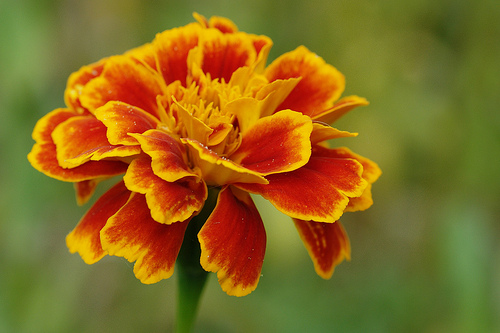I’ve left it a little late this year but I’ve finally got round to setting up my grow lights. The term grow lights can intimidate some chilli growers but hopefully in this post I’ll be able to explain that lighting setups need not be complicated or expensive while being of massive benefit to the hot pepper grower.
Since my first batch of seedlings germinated I’ve had them in my light box which is rigged up with 2 x 16 watts fluorescent tubes. Now that the plants have been re-potted i thought it right that i get them under my more powerful Compact Florescent Light CFL.
The light I use is 125 Watt CFL Purple Nuturlite. It delivers light at the both ends of the spectrum.
Previously only blue and Red CFLs were available. Blue bulbs are great for encouraging early foliage growth in young seedlings while red bulbs were used for encouraging flowering. Now purple bulbs (like the ones I use) cover both ends of the spectrum so seem like the obvious choice.
It’s worth noting that in order to set and ripen fruit plant require light from the other end of the spectrum so if you’re planning to grow your chillies fully indoors you should really look at investing in a HID system. I use lights to just get a head start on the season. Once the plant get near flowering I like to get them under the suns natural rays to take care of fruiting!
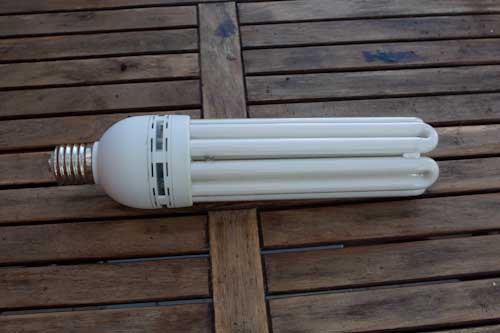 125 Watt Nurturlite
125 Watt Nurturlite
Grow light set ups need not be particularly expensive. I’ve had mine a few years now so I had a quick look on the internet to see what the going rates are these days. Here is a quick run down of the cost of comparable kit i use:
Of course you can save money by just buying the bulb and ballast. You could simply hang the bulb vertically above the plants though the efficiency will be less as light will be wasted by not having the light parallel to the plants.
Another solution is to build your own reflector out of stiff card or ply board covered in aluminum foil which will be grate at reflecting the light back onto the plants.
The ‘Build’
I had wanted to put a bit more love into this set up but a couple of things have stopped me. Firstly I’ve been so busy recently and really just need to get the plants under the lights as soon as possible in order to get my plants as developed as possible before the summer arrives. Secondly I’m not sure where the permanent position will be for the grow lights in the house. Both of these factors mean that for this year I’ve settled for a temporary solution.
After looking around i decided the easiest and most convenient place for the grow lights (for now) is under a table in the chilli house (a stand alone conservatory). Firstly it’s out of the house so I’ll no longer be cluttering up the kitchen with trays of seedlings plus I’ll quickly be able to move the plants to the table top each morning so they can benefit from natural sunlight during the day, before moving them back under the lights at night.
These lighting set ups are pretty simple really. First the ballast attaches to the reflector and is the part that you screw the bulb into. This is attached to the reflector which naturally bounces as much light as possible down onto the plants. In this case I simply attached the reflector to the under side of the table with the help of some garden wire.
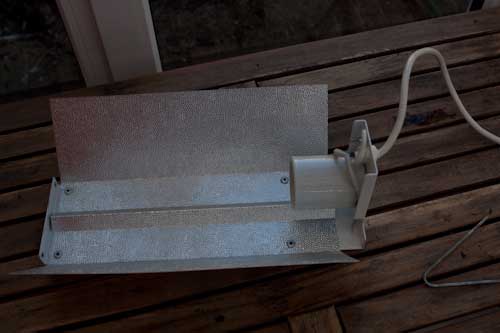 Reflector with ballast attached
Reflector with ballast attached
The reflector i bought came with two reel hangers that easily allow me to adjust the hieght of the light. This is great as I can quickly raiise the bulb hieght as the plants grow allowing me to maintain the optimum bulb to plant distance (about 10cm in my opinion).
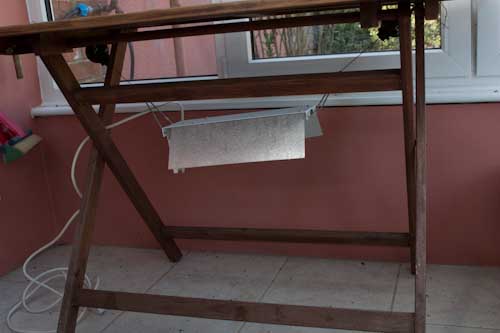
I found some old squares of roof insulation quilt in the shed that i’ve simply placed behind and at the sides of the setup. This will have two benefits; firstly it will help insulate the plants and keep them warm at night and secondly the reflective surface will help reflect even more of the light back onto the plants.
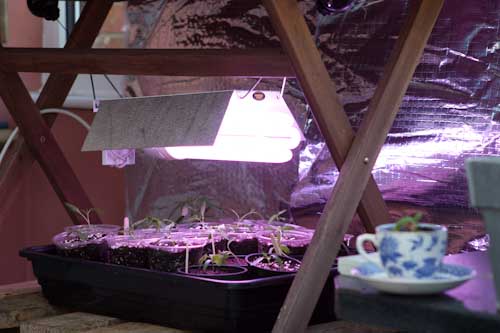
Over next winter i intend to build a more solid light box incorporating a small fan for ventilation, insulation and a fully reflective lining. Fans not only help keep the temperatures down (useful if your grow room/box is fully sealed unlike mine) but also help the plants to grow healthy strong stems.
The fact that i am now using a more powerful light, combined with the fact that the setup is in a standalone conservatory (and not part of the house) means i’ll need to pay more attention to the temperature the plants are in. I’ll aim to keep the night time temperature above 12 degrees by using a regular greenhouse heater. Any lower than this and the plants can go into shock and cease growing for a few weeks.
When the sun is out it can get very hot in the conservatory during the day. In addition the fact that it is not attached to the house (and central heating system) means it can also quickly gets cold at night, even with the heater. To help minimize any risks I keep a basic min/max thermometer in with the plants and check the temperatures at least twice a day. Also keeping an eye on the weather forecast is essential so i can pre-empt any extreme changes in the temperature.
Over the next 4 weeks or so I should see a massive burst of growth from the chilli plants. This should mean that by mid may when the weather is consistently hotter and the days longer I’ll no longer require the grow lights and will have fully matured plants ready to fruit just as the weather is perfect.


